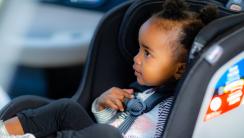Roberts Center for Pediatric Research 2716 South Street, 13th Floor Philadelphia, PA 19146
Breadcrumb
RESEARCH PORTFOLIO
Principal Investigator: Rachel Myers, PhD
The goal of this study is to create a unique source of epidemiologic crash data that enables novel description of use and installation patterns of child restraints among crash-involved children and— following linkage with hospital discharge and death certificate data—novel description of child occupant injury outcomes based on restraint use and installation (rear- vs. forward-facing).2025-2026
- Influence of Vehicle Rear Seat Design on Booster-Seated Pediatric Occupant Response in Frontal Impacts
Principal Investigator: Jalaj Maheshwari, MS
Vehicle seat design parameters can significantly affect the kinematics and kinetics of pediatric occupants in crashes. However, few studies have evaluated the effect of vehicle seat geometry and stiffness on a restrained child occupant. This study begins to explore the vehicle seat design parameters that have the greatest effect on booster-seated 6-year-old and 10-year-old occupant kinematics and kinetics in frontal impacts.
2024-2025
- Analyzing the Effect of Pretensioner Firing Times and Seat Belt Pull-in Lengths on Booster-seated Pediatric Occupant Kinematics and Kinetics
Principal Investigator: Jalaj Maheshwari, MS
This project aims to understand the effect of advanced restraints on the injury response of pediatric occupants restrained in the vehicle’s rear seat by examining the effect of different pretensioner firing times and seat belt pull-in lengths on booster-seated PIPER 6- and- 10-year-old pediatric human body models in full-frontal and far-side impacts.
2023-2024
- Anthropometric Variation in Premature Babies for Optimal CRS Fitment
Principal Investigator: Jalaj Maheshwari, MS
Testing standards, which regulate design of child restraint systems (CRS), have set upper weight limits for children. However, there is no regulation on the lower weight limit. CRS manufacturers generally recommend a 5 pound lower weight limit, which creates a challenge for premature infants who often weight less than 5 pounds. The specific aim of this study is to collect and analyze anthropometric dimensions across a range of low birth weight and…
2022-2023
- Quantifying the Q3s ATD Responses in CRS Harness Misuse Cases in Far-side Impacts on the FMVSS 213 NPRM Test Bench
Principal Investigator: Jalaj Maheshwari, MS
This study examines the effects of 5-point harness misuse on the kinematic and kinetic response of a Q3s anthropomorphic test device (ATD) restrained in a forward-facing child restraint system on the new FMVSS 213 NPRM test bench.
2021-2022
- IIHS Side Impact Barrier 2.0: Exploring the Effect of the Upgraded Barrier Impact on Naturalistically Seated Pediatric Occupants in Booster CRSs
Principal Investigator: Jalaj Maheshwari, MS
The goal of this study is to utilize computational modeling to examine the kinematics and kinetics of naturalistically booster-seated pediatric human body models as per The Insurance Institute for Highway Safety's new side impact test protocol.- Naturalistic Seating Postures in Frontal Impacts - Translating the Effect of ATD Seating Posture to Booster CRS Sled Testing Using the Q6 ATD
Principal Investigator: Jalaj Maheshwari, MS
This project aims to examine the effect of different seating postures on the kinematic and kinetic response of optimal and sub-optimal belt fit using a booster-seated Q6 anthropomorphic test device (ATD) and to quantify the variation across postures and child restraint systems in a frontal impact.
2020-2021
- Analysis of Sensor Technologies for Pediatric Vehicular Heatstroke Prevention Based on Real-world Data
Principal Investigator: Jalaj Maheshwari, MS
This project focuses on pediatric vehicular heatstroke and aims: 1) to review real-world vehicular heatstroke cases caused by different circumstances and to determine prevention and alerting technologies, and 2) to document, relevant to heatstroke prevention, different educational efforts undertaken to inform parents and caregivers, and strategies used by vehicle and child seat assessment programs.- Rear-seated Occupant Kinematics and Kinetics in Small and Moderate Overlap Crashes: Restraint Characteristics and Occupant Interaction
Principal Investigator: Jalaj Maheshwari, MS
The goal of this study is to systematically explore the kinematics and kinetics of adjacent rear-seated pediatric occupants under different vehicle seat belt restraint characteristics, child seats, and seating positions in small and moderate overlap crashes.
2019-2020
- A Naturalistic Seating Study of Children in Booster Seats with the PIPER Human Body Model; Frontal and Oblique Impacts in the Vehicle Environment with SCAB and AEB
Principal Investigator: Jalaj Maheshwari, MS
The first goal of this study is to systematically evaluate the naturalistic seating position of the 6YO and 10YO using the PIPER human body model to understand their response (kinetics and kinematics) in frontal and frontal-oblique impacts. A second goal is to use real-world seating conditions, such as a vehicle model with the front seats, SCAB and AEB pulse using a combination of sled testing and computational modeling.
2018-2019
- Biomechanics in Autonomous Vehicles: A Pilot Study to Explore Responses of Pediatric Occupants in Non-traditional Seating Conditions
Principal Investigator: Jalaj Maheshwari, MS
Autonomous vehicle seating designs have non-traditional seating positions, which potentially give rise to new impact conditions. Using computational modeling, this study explores the implications of non-normative seating conditions on booster seat-restrained pediatric occupants in simulated high-speed rear impacts.

